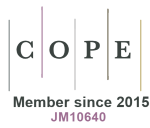Diagnostic impact of CEA and CA 15-3 on monitoring chemotherapy of breast cancer patients
Chemotherapy monitoring by serum markers
DOI:
https://doi.org/10.33393/jcb.2022.2446Keywords:
Breast cancer, CEA, CA 15-3, Chemotherapy, PrognosisAbstract
Objective: Serum tumor markers has been evolved as an effective tool to determine prognosis and treatment efficiency in different types of cancer. The aim of this study was to explore the chemotherapy monitoring efficiency and prognostic sensitivity of tumor associated cancer antigen 15-3 (CA 15-3) and carcinoembryonic antigen (CEA) markers in early (II) and late (IV) clinical stages of breast cancer patients.
Methods: CA 15-3 and CEA serum levels were assessed in 56 breast cancer patients at early II (n = 26) and late IV (n = 30) clinical stages with primary inclusion criteria: who received adjuvant chemotherapy AC (Adriamycin & Cyclophosphamide) or AC-T (Adriamycin & Cyclophosphamide followed by Taxane) regimes and human epidermal growth factor receptor 2 (HER2) negative by using particle enhanced turbid metric assay.
Results: Higher elevation of CA 15-3 as compared to CEA in pre-treatment group of breast cancer patients as compared to healthy control was observed. Late-stage patients showed higher positive serum levels as compared to early-stage one for both markers with preference of CA 15-3 over CEA. AC-T chemotherapy regime treatment in both clinical stages revealed significantly higher level of both markers as compared to AC regime with preference of CA 15-3 over CEA at late stage. Both markers levels were significantly higher in late-stage group as compared with early-stage ones for both chemotherapy regimens.
Conclusion: CA 15-3 is more efficient as prognostic monitoring marker in comparison with CEA and revels a positive connection between chemotherapy regime system and staging, more observed in late-stage.
References
- Abdel-Razeq H, Mansour A, Jaddan D. Breast cancer care in Jordan. JCO Glob Oncol. 2020;6(6):260-268. https://doi.org/10.1200/JGO.19.00279 PMID:32083950
- Therasse P, Arbuck SG, Eisenhauer EA, et al. New guidelines to evaluate the response to treatment in solid tumors. European Organization for Research and Treatment of Cancer, National Cancer Institute of the United States, National Cancer Institute of Canada. J Natl Cancer Inst. 2000;92(3):205-216. https://doi.org/10.1093/jnci/92.3.205 PMID:10655437
- Alunni-Fabbroni M, Müller V, Fehm T, Janni W, Rack B. Monitoring in metastatic breast cancer: is imaging outdated in the era of circulating tumor cells? Breast Care (Basel). 2014;9(1):16-21. https://doi.org/10.1159/000360438 PMID:24803882
- Bidard FC, Hajage D, Bachelot T, et al. Assessment of circulating tumor cells and serum markers for progression-free survival prediction in metastatic breast cancer: a prospective observational study. Breast Cancer Res. 2012;14(1):R29. https://doi.org/10.1186/bcr3114PMID:22330883
- Liu L, Xu HX, Wang WQ, et al. Serum CA125 is a novel predictive marker for pancreatic cancer metastasis and correlates with the metastasis-associated burden. Oncotarget. 2016;7(5):5943-5956. https://doi.org/10.18632/oncotarget.6819 PMID:26745601
- Falzarano R, Viggiani V, Michienzi S, et al. Evaluation of a CLEIA automated assay system for the detection of a panel of tumor markers. Tumour Biol. 2013;34(5):3093-3100. https://doi.org/10.1007/s13277-013-0877-x PMID:23775009
- Thompson JA, Grunert F, Zimmermann W. Carcinoembryonic antigen gene family: molecular biology and clinical perspectives. J Clin Lab Anal. 1991;5(5):344-366. https://doi.org/10.1002/jcla.1860050510 PMID:1941355
- Molina R, Auge JM, Farrus B, et al. Prospective evaluation of carcinoembryonic antigen (CEA) and carbohydrate antigen 15.3 (CA 15.3) in patients with primary locoregional breast cancer. Clin Chem. 2010;56(7):1148-1157. https://doi.org/10.1373/clinchem.2009.135566 PMID:20472825
- Uehara M, Kinoshita T, Hojo T, Akashi-Tanaka S, Iwamoto E, Fukutomi T. Long-term prognostic study of carcinoembryonic antigen (CEA) and carbohydrate antigen 15-3 (CA 15-3) in breast cancer. Int J Clin Oncol. 2008;13(5):447-451. https://doi.org/10.1007/s10147-008-0773-3PMID:18946756
- Dnistrian AM, Schwartz MK, Greenberg EJ, Smith CA, Schwartz DC. CA 15-3 and carcinoembryonic antigen in the clinical evaluation of breast cancer. Clin Chim Acta. 1991;200(2-3):81-93. https://doi.org/10.1016/0009-8981(91)90080-V PMID:1777973
- Jezersek B, Cervek J, Rudolf Z, Novaković S. Clinical evaluation of potential usefulness of CEA, CA 15-3, and MCA in follow-up of breast cancer patients. Cancer Lett. 1996;110(1-2):137-144. https://doi.org/10.1016/S0304-3835(96)04473-4 PMID:9018092
- Robertson JF, Jaeger W, Syzmendera JJ, et al; European Group for Serum Tumour Markers in Breast Cancer. The objective measurement of remission and progression in metastatic breast cancer by use of serum tumour markers. Eur J Cancer. 1999;35(1):47-53. https://doi.org/10.1016/S0959-8049(98)00297-4 PMID:10211087
- Duffy MJ, Shering S, Sherry F, McDermott E, O’Higgins N. CA 15-3: a prognostic marker in breast cancer. Int J Biol Markers. 2000;15(4):330-333. https://doi.org/10.1177/172460080001500410 PMID:11192829
- Kurebayashi J. [Biomarkers in breast cancer]. Gan To Kagaku Ryoho. 2004;31(7):1021-1026. PMID:15272579
- Shering SG, Sherry F, McDermott EW, O’Higgins NJ, Duffy MJ. Preoperative CA 15-3 concentrations predict outcome of patients with breast carcinoma. Cancer. 1998;83(12):2521-2527. https://doi.org/10.1002/(SICI)1097-0142(19981215)83:12<2521::AID-CNCR17>3.0.CO;2-A PMID:9874458
- Jäger W, Eibner K, Löffler B, Gleixner S, Krämer S. Serial CEA and CA 15-3 measurements during follow-up of breast cancer patients. Anticancer Res. 2000;20(6D):5179-5182. PMID:11326691
- Zhao S, Mei Y, Wang J, Zhang K, Ma R. Different levels of CEA, CA153 and CA125 in milk and benign and malignant nipple discharge. PLoS One. 2016;11(6):e0157639. https://doi.org/10.1371/journal.pone.0157639 PMID:27327081
- Edge SB, Compton CC. The American Joint Committee on Cancer: the 7th edition of the AJCC cancer staging manual and the future of TNM. Ann Surg Oncol. 2010;17(6):1471-4. https://doi.org/10.1245/s10434-010-0985-4 PMID:20180029
- Vizcarra E, Lluch A, Cibrián R, et al. Value of CA 15.3 in breast cancer and comparison with CEA and TPA: a study of specificity in disease-free follow-up patients and sensitivity in patients at diagnosis of the first metastasis. Breast Cancer Res Treat. 1996;37(3):209-216. https://doi.org/10.1007/BF01806502 PMID:8825132
- Geraghty JG, Coveney EC, Sherry F, O’Higgins NJ, Duffy MJ. CA 15-3 in patients with locoregional and metastatic breast carcinoma. Cancer. 1992;70(12):2831-2834. https://doi.org/10.1002/1097-0142(19921215)70:12<2831::AID-CNCR2820701218>3.0.CO;2-8PMID:1451063
- Ebeling FG, Stieber P, Untch M, et al. Serum CEA and CA 15-3 as prognostic factors in primary breast cancer. Br J Cancer. 2002;86(8):1217-1222. https://doi.org/10.1038/sj.bjc.6600248PMID:11953875
- Banin Hirata BK, Oda JM, Losi Guembarovski R, Ariza CB, de Oliveira CE, Watanabe MA. Molecular markers for breast cancer: prediction on tumor behavior. Dis Markers. 2014;2014:513158. https://doi.org/10.1155/2014/513158 PMID:24591761
- Moazzezy N, Farahany TZ, Oloomi M, Bouzari S. Relationship between preoperative serum CA 15-3 and CEA levels and clinicopathological parameters in breast cancer. Asian Pac J Cancer Prev. 2014;15(4):1685-1688. https://doi.org/10.7314/APJCP.2014.15.4.1685 PMID:24641390
- Agrawal AK, Jelen M, Rudnicki J, et al. The importance of preoperative elevated serum levels of CEA and CA15-3 in patients with breast cancer in predicting its histological type. Folia Histochem Cytobiol. 2010;48(1):26-29. https://doi.org/10.2478/v10042-010-0030-2PMID:20529812
- Fu Y, Li H. Assessing clinical significance of serum CA15-3 and carcinoembryonic antigen (CEA) Levels in breast cancer patients: a meta-analysis. Med Sci Monit. 2016;22:3154-3162. https://doi.org/10.12659/MSM.896563 PMID:27596019
- Yang Y, Zhang H, Zhang M, Meng Q, Cai L, Zhang Q. Elevation of serum CEA and CA15-3 levels during antitumor therapy predicts poor therapeutic response in advanced breast cancer patients. Oncol Lett. 2017;14(6):7549-7556. https://doi.org/10.3892/ol.2017.7164PMID:29344201
- Duffy MJ. Serum tumor markers in breast cancer: are they of clinical value? Clin Chem. 2006;52(3):345-351. https://doi.org/10.1373/clinchem.2005.059832 PMID:16410341
- Al-azawi D, Kelly G, Myers E, et al. CA 15-3 is predictive of response and disease recurrence following treatment in locally advanced breast cancer. BMC Cancer. 2006;6(1):220. https://doi.org/10.1186/1471-2407-6-220 PMID:16953875
- Nisman B, Maimon O, Allweis T, et al. The prognostic significance of LIAISON(R) CA15-3 assay in primary breast cancer. Anticancer Res. 2013;33(1):293-299. PMID:23267160
- Kim HS, Park YH, Park MJ, et al. Clinical significance of a serum CA15-3 surge and the usefulness of CA15-3 kinetics in monitoring chemotherapy response in patients with metastatic breast cancer. Breast Cancer Res Treat. 2009;118(1):89-97. https://doi.org/10.1007/s10549-009-0377-2 PMID:19322651
- Agha-Hosseini F, Mirzaii-Dizgah I, Rahimi A. Correlation of serum and salivary CA15-3 levels in patients with breast cancer. Med Oral Patol Oral Cir Bucal. 2009;14(10):e521-e524. https://doi.org/10.4317/medoral.14.e521 PMID:19680209
- Ali HQ, Mahdi NK, Al-Jowher MH. The value of CA15-3 in diagnosis, prognosis and treatment response in women with breast cancer. J Pak Med Assoc. 2013;63(9):1138-1141. PMID:24601193
- Kobayashi S, Iwase H, Karamatsu S, Matsuo K, Masaoka A, Miyagawa T. The clinical value of serum CA15-3 assay postoperatively in breast cancer patients. Jpn J Surg. 1989;19(3):278-282. https://doi.org/10.1007/BF02471402 PMID:2779026
- Di Gioia D, Heinemann V, Nagel D, et al. Kinetics of CEA and CA15-3 correlate with treatment response in patients undergoing chemotherapy for metastatic breast cancer (MBC). Tumour Biol. 2011;32(4):777-785. https://doi.org/10.1007/s13277-011-0180-7 PMID:21553235
- Devine PL, Duroux MA, Quin RJ, et al. CA15-3, CASA, MSA, and TPS as diagnostic serum markers in breast cancer. Breast Cancer Res Treat. 1995;34(3):245-251. https://doi.org/10.1007/BF00689716 PMID:7579489
- Thriveni K, Krishnamoorthy L, Ramaswamy G. Correlation study of carcino embryonic antigen & cancer antigen 15.3 in pretreated female breast cancer patients. Indian J Clin Biochem. 2007;22(1):57-60. https://doi.org/10.1007/BF02912882 PMID:23105653
- Sørbye H, Dahl O. Transient CEA increase at start of oxaliplatin combination therapy for metastatic colorectal cancer. Acta Oncol. 2004;43(5):495-498. https://doi.org/10.1080/02841860410032380 PMID:15360055
- Ailawadhi S, Sunga A, Rajput A, Yang GY, Smith J, Fakih M. Chemotherapy-induced carcinoembryonic antigen surge in patients with metastatic colorectal cancer. Oncology. 2006;70(1):49-53. https://doi.org/10.1159/000091184 PMID:16446549
- Strimpakos AS, Cunningham D, Mikropoulos C, Petkar I, Barbachano Y, Chau I. The impact of carcinoembryonic antigen flare in patients with advanced colorectal cancer receiving first-line chemotherapy. Ann Oncol. 2010;21(5):1013-1019. https://doi.org/10.1093/annonc/mdp449PMID:19861580
- Takahashi N, Shimada T, Ishibashi Y, Oyake N, Murakami Y. Transient elevation of serum tumor markers in a patient with hypothyroidism. Am J Med Sci. 2007;333(6):387-389. https://doi.org/10.1097/MAJ.0b013e318065b023 PMID:17570994
- Klapdor R, Bahlo M, Babinski A. Atypical courses of serum tumor markers—4 case reports. Anticancer Res. 2003;23(2A):845-850. PMID:12820311
- Harris L, Fritsche H, Mennel R, et al; American Society of Clinical Oncology. American Society of Clinical Oncology 2007 update of recommendations for the use of tumor markers in breast cancer. J Clin Oncol. 2007;25(33):5287-5312. https://doi.org/10.1200/JCO.2007.14.2364PMID:17954709










